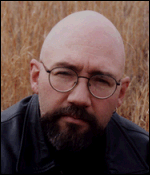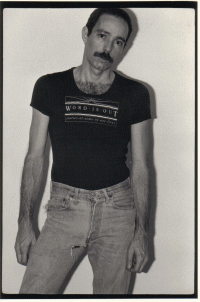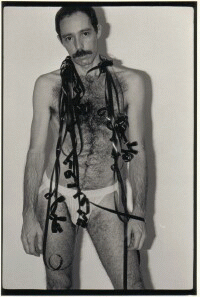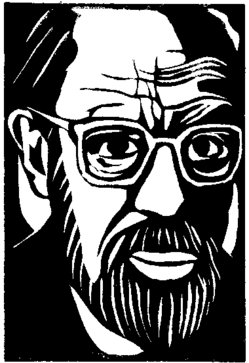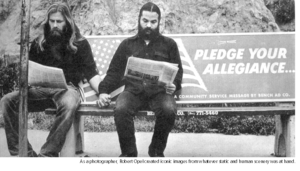 LONG-HAIRED MEN AND SHORT-HAIRED WOMEN
LONG-HAIRED MEN AND SHORT-HAIRED WOMEN
Hidden Bohemia in Los Angeles
by Stuart Timmons
"The City Council yesterday passed an ordinance forbidding street speakers from holding forth on ‘Radical Row’…The long-haired men and short-haired women have thirty days to make welkin ring in that locality, after which the nation’s problems will be settled in the Plaza." Los Angeles Times, 1923
Every city has them. Those short haired-women and long-haired men who make the skies echo with their public opinions and rooms glow with their aesthetic visions. Artists, writers and their ersatz communities provide an age-old refuge for those not bound by society’s moral- and especially sexual-conventions. Free spirits have existed in every era, from the Lost Generation to the Love Generation, but many generations have simply called them Bohemians.
These communities were not “gay ghettos” and rarely part of an organized gay rights movement. Though an overlap with gay life was frequent-to-inevitable, they were defined more by a devotion to aesthetics over conformity; sexual expression did not necessarily take precedent over artistic expression. An actor in 1840 described Bohemians as persons “located nowhere and whom one encounters everywhere, who have no single occupation and who exercise fifty professions…[who are] ready to live honestly if they can and some other way if they can’t.” Though Bohemia is not an overtly protected zone for gay people, it is idealized for a reason: it is often the most fulfilling part of their lives.
The two are often linked; one recent gay history, by Daniel Hurewitz, is called Bohemian Los Angeles, and the very words were even synonymous, as a 1910 article, “The Gay Life of the City,” about Bohemian haunts at L.A.’s beaches. Indeed, L.A. has a long avant-garde tradition intertwined with its gay people. Sitting at the edge of America, it’s a land of sunshine where cheap rents seemed (‘til recently) endless. Aside from its climate, Los Angeles has always offered the resource of space; as a city of some 450 square miles, its valleys, canyons, and mild beaches, form many neighborhoods that have welcomed odd ducks for years.
As early as 1887, a newcomer to L.A. named Harry Carr found an area near the central Plaza that had turned from “the first fashionable apartment houses” in town, whose tenants were mostly attorneys, to “the Greenwich Village of Los Angeles,” where impoverished artists and writers “contested as to which could wear the funniest looking hair and talk the loudest.” Carr later moved to the real Manhattan but returned soon. What he came back for, he rhapsodized, included seeing “mountains changing from a delicate salmon color to scarlet to rose…and then to violets and blue….and we go to sleep with the odor of orange blossoms mixing into our dreams.”
By the turn of the century, L.A. began to boast a Bohemian colony in its newspapers. In what had been so recently a cow town, artists stood out: Paul De Longpré, the renowned flower painter who left France for Los Angeles to become “art’s most impassioned flower lover;” miniaturist painter C. Albert Browne, a British ex-patriot, who created tiny masterpieces on ivory and porcelain. Both were profiled, along with half a dozen other artists, in the L.A. Times. By 1901, L.A.’s Jonathan Club held a Bohemian Ball, proclaiming, “If joy unconfined defines Bohemianism, who would not be one at least one night a year?” A year-round colony of artists and writers who preferred society’s margins lived in Bunker Hill. A fashionable housing district in the 1870s, its stunning views, by the turn of the century, gave way to apartment buildings, often catering to single men. By pure coincidence, the market in the heart of this gay neighborhood was known as the Budget Basket.
By the teens the district was known for its concentration of men who appeared employed and “decent” by day, but haunted Central Park (noted even by Hart Crane) and various clubs and bars where they could find one another. Bunker Hill was eventually described as a “secondary Skid Row” by the Los Angeles police, with bars on Hill and Third Streets that were “notorious as hangouts for undesirables.” Some of these “undesirables” plied the straight sex trade, like the Madame, “Mumsie” McGonigle of Bunker Hill Avenue. Even local bars with such names as the Gay Inn and the Gayway Café were known spots for female prostitutes — and were also popular for gay men.
The Bachelors of Bunker Hill
The queer anchor to Bunker Hill was Central Park, renamed Pershing Square during World War I. World famous as the first stop for homosexuals who lived in or visited Los Angeles, the Square, as its devotees called it, was Free Speech Central for the city, more even than “Radical Row” on Los Angeles Street. Radicals and reformers of all varieties spoke to crowds of people, pigeons, and pervs in the lushly planted park. In the 1930s and ‘40s, activist Harry Hay recalled cruising the grounds there at night; others have recalled cruising and carrying on even during the day. Banana trees had become so overgrown that Jaime Green remembers finding the Square shortly after his arrival in Los Angeles in the early ‘40s, and learned that “sucking and fucking went on 24/7 in those bushes.” Hay once recalled mischievously that he’d run into actors and musicians in the foliage of the Square. When referring to one handsome artist, he quipped, “I didn’t know him well, but I knew him often.” With its surplus of bachelors’ apartments and bars like the Gayway, Pershing Square served as the take-off point for what many gays referred to as their “rounds,” which included area t-rooms and bars, as well as a secluded pick-up area known as Vaseline Alley. Historian Jim Kepner noted in the 1940s that the Square already had a gay culture that was decades old.
Bunker Hill even had its own radical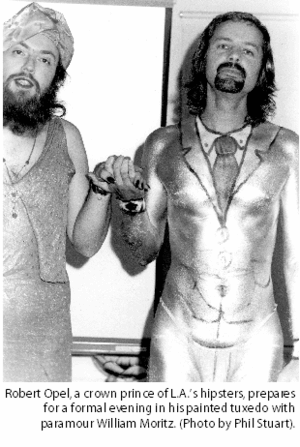 politician, Utah transplant Parley Parker Christensen, called “the bombastic bachelor of Bunker Hill” by the L.A. Times. Christensen, an advocate for women’s suffrage and the International Workers of the World, ran for President in 1920 on the Farmer-Labor party. He stood six foot four, favored white linen suits, and was known as a “flamboyant character” down to his flowing locks and his fluency in Esperanto. Neither his politics nor appearance, however, prevented his serving three terms on the Los Angeles city council. (Christensen was insightfully radical; he announced during a campaign that if the Republicans or Democrats won the White House again, “the government will remain on Wall Street.”) The certain sexuality of Christensen (like many of this period) is unknowable, but the milieu they lived in emerges as a free spirited bohemia.
politician, Utah transplant Parley Parker Christensen, called “the bombastic bachelor of Bunker Hill” by the L.A. Times. Christensen, an advocate for women’s suffrage and the International Workers of the World, ran for President in 1920 on the Farmer-Labor party. He stood six foot four, favored white linen suits, and was known as a “flamboyant character” down to his flowing locks and his fluency in Esperanto. Neither his politics nor appearance, however, prevented his serving three terms on the Los Angeles city council. (Christensen was insightfully radical; he announced during a campaign that if the Republicans or Democrats won the White House again, “the government will remain on Wall Street.”) The certain sexuality of Christensen (like many of this period) is unknowable, but the milieu they lived in emerges as a free spirited bohemia.
Beer and Ether
If communities of the artistic and open-minded germinated in the first decades of the new century, they flowered and multiplied by the 1920s due to the growth of the film industry. As the creative, the beautiful, and the ambitious poured into the Southland, the Bohemia and its lavender fringes swelled. Simultaneously, Prohibition ushered in the era of speakeasies, with their underground culture of sensuality, excess and giddy lawlessness. L.A. speakeasies were known for serving beer and ether as a masculine alternative to gin and orange juice; their clientele regularly giggled to drag performers, some of who even served the sandwiches.
Some drag performers even hit the big time, like Fred Covert, who during the teens and twenties performed under the sly stage name of “Ko Vert” and re-spelled his first name “Freddric.” There was little hidden about dancer Ko Vert, however; the papers noted his Vanity Dance and his Peacock Dance. An extravagant costumer, for his “Evil” dance, he applied gold leaf to his body. Ko Vert appeared in numerous films, including the silent Wizard of Oz (as the Phantom of the Basket) and once, in drag, opposite Rudolph Valentino. Ko Vert declined a New York offer to replace the aging Julian Eltinge, the nation’s foremost female impersonator, preferring to stay in L.A.
While Hollywood attracted Bohemians, its welcome proved mixed. The conservative and exclusive studio system was a magnet for artistic dreamers of a sensitive nature and boasted of its sophistication in matters gay, but that did not equate to acceptance or even tolerance. Malcolm Boyd, who arrived in L.A. in 1940 and became a publicist and producer, called it a “walled kingdom.” Once inside he learned, “if you wanted to stay, the rules were quite clear,” and fundamental to them were “never express yourself; never stand out.”
Though high-earning actors found some protection, free-spirited queers usually found themselves outside the wall, as did Harry Hay, whose 1930s attempts at acting and screenwriting amounted to little more than extra work and ghost writing. He even engaged in making a short film that featured him as an actor as well as a co-director, and spoofed the Surrealist art movement of Europe. His collaborators came from an art collective just off of Hollywood Boulevard called the Hollywood Film and Photo League. Because of its Depression poverty, the group jokingly called itself the “Filth and Famine League.” It was the only place in the film capital where international and experimental film was available to the public.
A quiet gay infrastructure continued to foster the arts at the compound of painter Grant Beach, who renovated a decaying Victorian on the outskirts of downtown L.A. from the late 1940s through the ‘50s. Beach, who was quietly homosexual, mounted exhibitions of paintings and ceramics (often featuring artists as far-flung as Europe and Japan), and offered classes. Though his gallery was small, his exhibits were startlingly visionary. In 1956, he exhibited Mexican art featuring work of Rivera, Siqueros, Orozco and others, four decades before a comparable show was mounted in L. A. He also played landlord; among his tenants was Evelyn Nesbit, whose beauty caused art and murder in 1906, but by the mid ‘50s was an eccentric cat lady (she had three). The Girl on the Red Velvet Swing taught sculpture at Beach’s School of Arts and Crafts.
Homo Beatniks
The national acquaintance of Bohemia was so entrenched by the 1950s — and so associated with queer sensibility and sexuality, that the only gay magazine in existence ran a cover story linking the two. “Homo Beatniks” proclaimed ONE Magazine in the summer of 1959, offering a five-page cover-story titled “The Homosexual and the Beat Generation.” Homoerotic details of Jack Kerouac, Neal Cassidy and Allen Ginsburg would leak out for years, but Ginsberg proclaimed to the New York Post that year, “I sleep with men and with women. I am neither queer nor not queer, nor am I bi-sexual. My name is Allen Ginsberg and I sleep with whoever I want.”
The author of “Homo Beatniks,” who was familiar with L.A.’s Bohemian center at Venice Beach, broadened that idea. “The beat-homo has no inhibitions…. He doesn’t give one goddam what the world thinks of him.” Recounting case studies of homo Bohos he had known, he captured the rebel nature of the demographic by quoting one of them: “The only reason I’m a Beatnik is that none of them try to pry into my personal life… I can get along with the other Beatniks because they don’t ask ‘personal’ questions.” ONE may have found particular interest in them because Beat writers Kerouac and Ginsberg often cited their mission as spiritual seekers, invoking the “wise fool” — which was the exact archetype adopted by the Mattachine Society, the group that gave birth to ONE, during the same era.
The simultaneity of the Beats and the homophiles poses a fascinating juxtaposition. The Beats fought for — and won — greater social and personal freedom, including freedom of sexual expression. Ginsberg’s landmark poem, “Howl,” elicited the legal term “redeeming social value” when a judge declared the poem not obscene, even though it railed against the corporate world and praised explicit gay sexuality in the guise of a Beat banshee. Homophile activists, ironically with their corporate personas and buttoned down rhetoric, made similar gains by winning a court case the same decade that allowed the words and ideas about homosexuality to be distributed through the mail. The publication of “Homo Beatniks” marks an unusual intertwining of two courses of action and activism for sexual and cultural expression. This resonance is increased when remembering that the homophiles had their own spiritual definition of homosexuality: The motto for
ONE was Thomas Carlyle’s quote, “a mystic bond of brotherhood makes all men one.”
The inheritors of the Beats, within a scant decade, identified as love children and flower children who trusted no one over 30 and created not just an enclave but an entire counterculture. One crown prince of the hippies was Robert Opel, an artist, writer, and activist whose handsome physicality were part of his merry prankster repertoire. Opel became most famous for streaking the 1974 Oscars, running past Liz Taylor and David Niven, who sniped about Opel’s “showing off his shortcomings.” In reality, Opel was an endowed exhibitionist, who frequently wore a transparent vinyl jumpsuit to parties; for more modest occasions, he wore only a G-string and body paint. Opel was part of L.A.’s queer hippie scene, which included other such artists as Buddha John Parker, actor Harry Frazier, and filmmaker William Moritz. (Among Moritz’s diverse and ingenious works stands out a satyr play, “Midas Well,” based on the premise that the first thing King Midas touched and turned to gold was, of course, his cock.) Opel not only streaked the Oscars, but also appeared nude in the Los Angeles City Council during a debate on banning nudity from L.A. beaches. “I thought the Council should see what an actual nude person looks like,” he said, as he stood less than an inch from the seated Chief of Police, Ed Davis. Darkly-tinged homoerotic culture flourished in Opel’s San Francisco art gallery, which hosted Robert Mapplethorpe’s second west coast exhibition and Tom of Finland’s first U.S. exhibit. But darkness closed in when, in 1979, at Fey Way Gallery, Opel fell victim to an assassin’s bullet.
On a recent call-in radio show discussing gay life in Los Angeles, the only call came from a young man who asked about the homogenization of gay culture and why it seemed that, if you didn’t have a specific view, one felt left “out of the community.” I was an on-air guest, and was haunted by this question. The great legacy of gay life, long before the movement for rights, has always been freedom from social conventions and expectations. While the movement has succeeded in what used to be unimaginable — making homosexuality respectable — there seems to be some discontent about what respectability has sacrificed.
Can gay men live on wedding cake alone? Can a small square sticker express a full range of political views? Another queer model exists besides uniform consumerism. The radical, the lyrical, the flamboyant and even the bombastic are a part of gay expression that should be eternal, despite the recommended public image counsel of polls and non-profits. More than a century ago, a “staid” visitor who “lost his cares for five hours” articulated this elusive lavender homeland:
Bohemia, in its purest sense is the intimate meeting and commingling of minds without false conventionalities, where one thinks, does, acts and speaks according to his individual capacity, impulse and mind… Where one for pure love’s sake and enjoyment gives, and, in giving, enjoys, and for like love and fellowship receives, and in receiving, enjoys.
This is just an excerpt from this issue of White Crane. We are a reader-supported journal and need you to subscribe to keep this conversation going. So to read more from this wonderful issue SUBSCRIBE to White Crane. Thanks!
Stuart Timmons is the author of The Trouble With Harry Hay and with Lillian Faderman Gay L.A.: A History of Sexual Outlaws,Power Politics, and Lipstick Lesbians reviewed in this issue of White Crane.
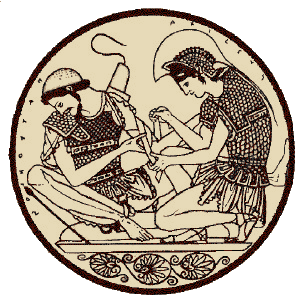 Achilles and Patroclus
Achilles and Patroclus